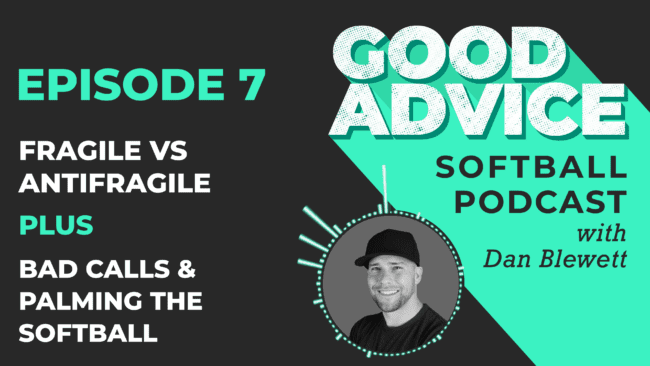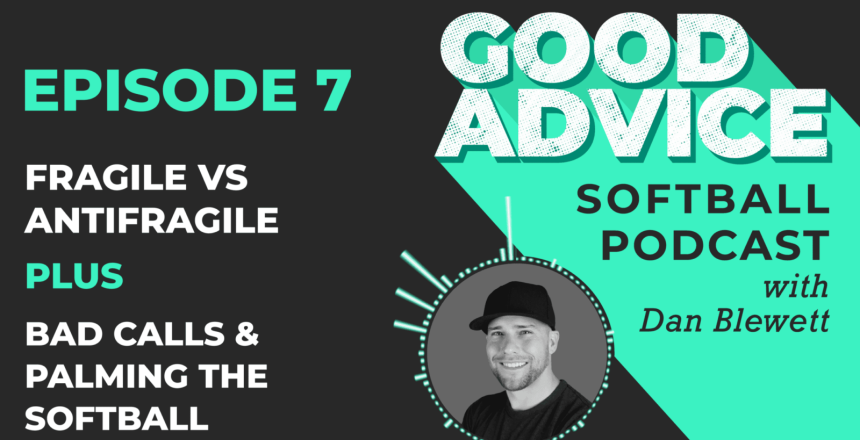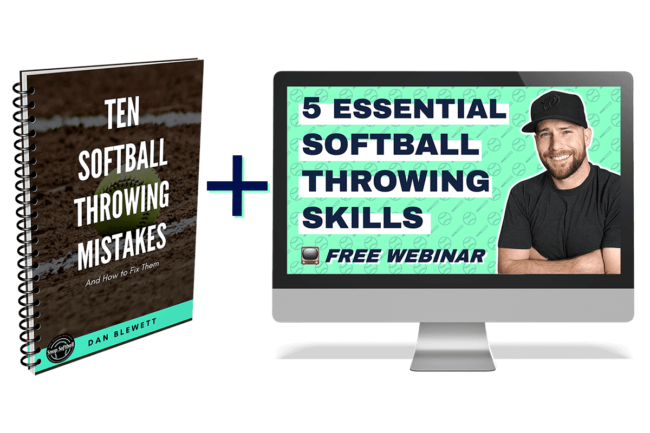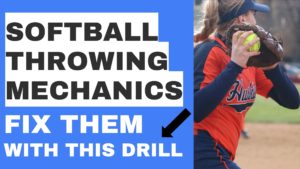*This article may contain product links which pay me a small commission if you make a purchase. Learn more.
Antifragile is a term for a system or thing getting stronger when exposes to stress. It’s different than resilience and Dan explains why building it is important for athletes. He discusses whether or not umpires are just a part of the field, and why players should check their grip on the softball.
Podcast: Play in new window | Download
Subscribe: Apple Podcasts | Spotify
To submit a question for the Good Questions Q&A segment, make a voice recording and email it to Dan at hello@danblewett.com.Want to support the show? Enroll in one of Coach Dan’s online throwing courses or his mental skills course. Use code GOODADVICE to save 20% on any course, just for being a listener.Sign up for Dan’s Email list and get his free throwing eBook, and follow up with him on the interwebs: YouTube Channel | Twitter | Snapsoftball.com
Full Transcript: EP7 Good Advice Softball Podcast: Are Athletes Fragile or Antifragile? Are bad umpires just a part of the field; Why You Shouldn’t Palm the Softball

You are listening to the good advice, softball podcast. I’m Dan Blewett. And on this show, you’ll learn how to help the softball player in your life. Sharpen her skills, improve her mindset and find new confidence through softball.
Welcome back. I’m Dan Blewett. This is the good advice softball podcast. And in today’s episode, we’re going to cover a couple of key topics. Number one. What does antifragile mean? I’ve been on a kick recently. I found a bunch of great stuff I’ve been really interested in. So one of them is a antifragile I’m currently underway.
And, um, there’s another book that I’ve been listening to called the coddling of the American mind. These two books kind of go hand in hand. So it’s really interesting. If we think about the term fragile, we, everyone knows what that is. Right? You look at a glass, you drop it on the ground at shatters, it’s fragile.
We know you’re China and you’re in your fancy covered. It’s is fragile. And we today I think young people more than ever have this sort of fragile mind, which can be caused by parents trying to pave the road for them to smoothly. Right. They want to. You just make everything in life easy. They don’t want to expose them to hard times hard ideas, like whatever it is, and they become sort of fragile.
They can’t handle these really tough situations they’re placed in. And so if you’ve ever read my book, do your baseball gods is my memoir. There’s a very constant theme flowing through it, which is that sports are profoundly difficult and the times cruel and it takes a lot of resolve to keep going. And really what.
And I wish I had known this term back when I was writing the book, but anti-fragile um, and this is by the author, Nassim Nicholas Teleb. He says there’s not a, uh, an, uh, Opposite word for the word fragile in the, in the human. Well, not in the human, but in the English language, the word resilient doesn’t explain what the opposite of fragile is.
So fragile is it’s breakable, right? And resilient means it’s robust. So if you have like a plastic bottle, You know, you can slam it on the ground. It’s not going to break. It’s very resilient to other forces, but if you slam a bottle on the ground, a bunch of times a plastic bottle, it doesn’t get stronger.
It just resists it. It stays the same, but things that are anti-fragile, they actually get stronger when stress is applied to them, which are, for example, bones. We know that for people that lift weights. Especially athletes who lift lots of weight, put big weights on their back. They, they dead lift, they squat, heavy weights, their bones become stronger and much more dense than people that don’t lift weights.
So their bones are, anti-fragile not only do they resist breaking the more their stress, but they grow stronger because they’re stressed. And the, the central point in this book and this other book is that. A lot of the times society right now, we’re allowing kids to be fragile. We’re saying that we don’t want to expose you to these hard times, these, these, um, even like things in history, it’s like, we’re trying to wipe away the history books.
Sometimes we don’t want to teach kids things that are going to make them think or make them feel. You know, anxious or making them feel, I don’t know. Um, we, you know, we have a dark history in American history and we don’t want to expose kids sometimes to some of the awful things we’ve done to other human beings.
That’s a very fragile, that’s creating more fragile kids, essentially. They don’t know how to handle things in the future because we’re not. Giving them stressors to make them stronger. We’re not helping them become anti-fragile. And so with athletics, this goes back to letting your kids ride the bench, putting them on competitive teams where they’re going to have to really pull themselves up to that level.
And out-compete other kids to get in the lineup. Otherwise, they’re going to be sad and sit on the bench and watch their teammates get all the innings. Those are things that are good experiences for them that help them become anti-fragile. So. One of the things that, that frustrates me as I see the way kids are coming up is, is parents trying to pave their way up the mountain to D one softball or to major league baseball or whatever, by calling coaches and vouching for them that they should, you know, get more playing time or they should be playing in this position, you know, buying them the like, Overly lavishly, expensive equipment that they don’t need to try to give them every little advantage, um, you know, forming a new team for them so they can be starting shortstop if they can’t start at their other team, you know, jumping ship to a new team every year, these are all things that make kids more fragile.
They make them, Oh, I couldn’t hack it here. So dad may be a new team and now I’m on that team so that I can, I can get more playing time that doesn’t help them become. Antifragile where they get stronger over time and more resilient. Rather. It just says when things are hard, we’ll make them easier for you.
So I’d like you to consider this idea of how you can help the kids in your life. Whether you’re a coach or parent become more anti-fragile this is something that I’ve been preaching for many years. It didn’t really have a term for it. That these things are good for them. When a coach choose your kid out for jogging down the line and they cry in the, in the dugout because they got chewed out.
That’s a good thing for them. That’s not a bad thing for them. You can’t get rid of all that stuff because they just become more fragile. Whereas. Tough coaches, tough competition, you know, sitting the bench, not getting everything you want. Those stressors make you stronger over time, um, because you have no choice, but to adapt, if you want to get back on that field and you’re on the bench, what are you going to do?
You gotta go practice more. You’re right. And that’s what, so what it takes, I’m making a new team so that they can not practice, but still get playing time does not help them in a longterm. And, uh, again, like going back to my story as an athlete, my story, my, my road was very long. It was very bumpy. I had multiple elbow surgeries.
I had multiple times when I just like, couldn’t get out there on the field. Um, because of injury cause of pain I had. Been chewed out by many coaches. Um, and I have many different coaches who gave me different things because of the way they interact with me. They all in their own way made me more resilient, um, than I already was.
Not just in, you know, keeping my constant level of resilience. Cause we all have a sort of an innate level of resilience. Some people are born a little more. Tough than others, but they made me tougher. They made my bones and my skin thicker over time because of the way they coached me. So I’m just, I’m going to leave you with that.
I think this idea of antifragility is interesting and I think we all know this to be true. Um, I think we all just need to revisit what we’re doing. And ask ourselves and have this tough look in the mirror of saying is the way that I’m coaching my team or my daughter, or just the way I’m raising her. Is this something that’s going to, am I doing things to make her more fragile in the future?
Or am I doing things to make her antifragile
all right. In today’s 92nd mindset, I want to cover good and bad luck. And how umpires are a part of that. So I’ve. Talked about this a number of times. And I firmly believe that the best way to view umpires is that they are part of the playing field. And this is good for players is good for parents. Go for coaches.
You should view umpires just the same as if they’re a, a puddle of water. In short right field that when the ball hits it it’s skids. And, uh, it just becomes a hit because of it, right. Or a piece of a big chunk of dirt in between short and third, that it hits it and vaults over your third baseman’s head.
And it makes a routine ground ball become a single, um, all these factors in softball. They’re never going away. There’s tons of good luck and bad luck. There’s tons of variables and every different field. There’s different field conditions. There’s different, you know, distances in the Al fields. Sometimes you play on a tiny ballpark with a big hitting team and they hit a ton of home runs and it’s like, what is going on?
Those are things you can’t control. And they’re just part of the game. Honestly, I think there are things that make the game great and extra interesting. You know, basketball’s boring. I mean, I guess it’s an opinion, but I think part of the reason basketball is somewhat boring. I think it’s boring on a lot of different levels, um, is that the field is always the same, right?
The court is constant, right? Like the stain might be different or whatever, but. It’s a pretty sterile environment. Right? But it’s interesting that every field is a little bit shaped is shaped different, right? The outfield walls are different. The foul poles are different. The grass is different. The turf is different.
The, the dirt is different. Those are all fascinating and interesting things about softball. And so the umpires, yes, they screw up and yes, we want them to make the right call all the time. But we know they’re not going to. And when we really were to, if we were to average it out somehow over the course of 40 50 games, or especially over five, 10 years of softball, there’s always going to be a distribution that’s relatively equal on both sides that you got a good amount of good luck and a good amount of bad luck.
You’ve got a good amount of good calls and bad calls. You got good calls at really terrible times. And you’ve got good calls that really bad times, um, or at good times. You know, it’s, it’s the timing of all of it. And the quality of the calls are going to be relatively distributed equally over a long sample size.
So really the best way to think of umpires because they’re trying their best. No empire is trying to be a crappy empire. That’s is not how it is a give them the benefit of the doubt, but B just assume the umpires are like bad hops. Just assume that they’re like a rain shower some days I just, it just pours on you and it sucks playing softball that day.
Sometimes you have a pair of umpires that just suck and it just makes the game a little worse, but it’s still a game and it’s still the same conditions for both teams, right? It doesn’t rain on just one dugout. It rains on both dugouts and the umpires are going to be bad for both dugouts. And even when they’re seemingly bad for one team and not the other.
It’s not because they’re trying to do that. It’s just like, that’s just how the cookie crumbled that day. So I think if you start to consider the umpires, not as well, consider them as people because they are, but consider the calls that they make as part of the field, rather than these two humans that are going to determine our fate.
Cause that’s not really what they are really. They’re just making calls to the best of their ability and that. That best of their ability, uh, good and bad calls. Those are getting folded in with the rest of the good and bad luck of the game. So if you just consider umpires would be part of the field that, you know, they’re not going to be perfect some days they’re going to be better than others.
It’s a good way of just saying, you know what. You win. Some you lose some, some days are easier than others. Some days you have good luck. Some days you have bad luck. I think that allows everyone to sort of like stop worrying about it and just do what you can do and control what you can control. Alright, it’s time for good questions.
Our listener Q and a segment. Remember if you have a question you’d like answered on the show, please email a voice recording. To hello@danblewett.com. This is easy to do on your phone, through the voice memos app on iPhones or any voice recorder app on Android links to email me are in the show notes.
All right. And today’s question was a YouTube question and it’s how deep should the ball be held in my hand? So I worked with a lot of players over the years who, when they hold a softball, it’s like their fingers are pressing and into their Palm, which just makes no sense. Uh, just, you know, if you’re gonna try to throw anything hard, whether you’re just picking up a rock or a baseball, tennis ball, softball, if you’re just going to pick up and throw anything.
It’s typically going to feel the most comfortable out in your fingertips. Like just naturally, you’re going to want the ball out on your fingertips because that’s where, you know, it’s going to leave. So when you start gripping something with your fingers, pushing into the center of your Palm, and this is only for your parents and coaches, just to do a quick check one day.
So before practice, just run out there and say, Hey. Everyone get a, get a ball in your hand and get your grip as if you’re about to throw it across the diamond. And then just let me see it. Just go through your, your team or your group, and just look and see how many of the balls appear to be held in the Palm.
Where a lot of times the thumb is on the side of the ball, and that is a big no-no because then it’s a hundred percent like a Palm ball where the pressure has to be fingers into your Palm, the thumb, even with small hands, the thumb should be a basically opposing the fingers. So. Pointing towards your fingertips.
Your fingertips should point toward your thumb. Your thumb should point toward your fingertips so that the ball can be held somewhat away from the Palm. Obviously with small hands and a really big soft ball, it’s going to come in contact with your Palm. So I’m not saying it’s either coming in contact with your Palm, but there’s a difference between the pressure going from fingertips to thumb, which is how it should be held.
So if you just make a C with your hand right now, And think about squeezing something, that’s kind of how the softball should be held rather than putting your thumb. If you took your thumb right to your side of your hand. And then take your fingertips and squeeze towards your Palm. Like make that self, like I’m doing a one hand clapping that thing.
Um, that’s how a lot of players hold it when their thumbs on the side. So that’s a big no-no because now essentially you’re shortening the lever when you throw and you’re making it more like a catapult rather than like a whip. So your fingers as they come through, they’re going to be the last, like your fingertips or the last thing on the softball.
Um, but when you’re holding it in your Palm, it’s going to roll out completely differently. And that’s just not what we want. So, uh, just as a quick tip today, again, Ask a player just to grab a ball naturally. Don’t tell them what you’re doing. And then just say, Hey, let me see your grip. Turn your Palm up.
Let me see it and just see how many kids have their thumb on the side and how many, it seems like the pressure is fingertips pushing into the middle of their Palm. You don’t want that. So if you find that correct it, by asking them to slide their thumb underneath the ball a little bit better, where the ball starts to push a little bit.
Out from their Palm and now their pressures coming from their fingertips down toward the thumb.
Well, that’s all the good advice I’ve got for today. If you enjoy the show and would like to support me while also helping yourself enroll today in one of my online softball courses. My she’s got a cannon throwing courses, come with pricing plans for any budget. And my resolute athlete, mental skills course will help your daughter or team build the mindset of a champion enroll in any of my courses through the links in the show notes and save 20% with code good advice just for being a listener.
Be sure to subscribe to my weekly email list where you’ll get updates on all my new videos and episodes, nearly 4,000 people get my emails and you should too. Sign up for the link in the show notes. Lastly, who do you know, who can use some good advice? Please share this podcast with a friend, subscribe on iTunes, Spotify, or wherever you listen to podcasts and subscribe to my snap softball, YouTube channel, where you’ll find this podcast and hundreds of softball, instructional videos.
Back when I was a player, I was always thankful for good coaches and good advice. I’m Dan Blewett and I’ll see you next time.






